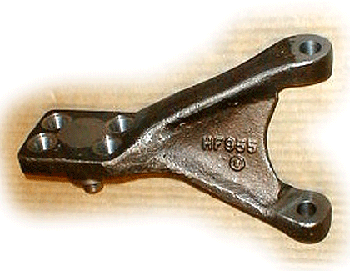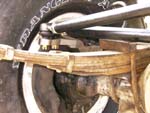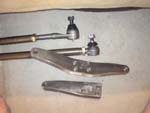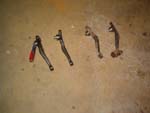
Steering Setups Because your leaf springs are now above your axles, you'll notice that your OEM steering will not work any more. There are two types of different steering setups to deal with this, and a bunch of different companies who make them. They are the high steer system, and a double steering arm system (sometimes called "crossover steering"). Unfortunately, steering is probably the biggest single expense of a spring over and will cost you at least $200-$500 depending on which setup you use. Crossover Steering:
Its disadvantages is that it allows the tie rod to hang in front of your axle, so if you were on a tough stretch of trail and were to hit a rock, it could damage your steering. Likewise, because your springs are now above your axle, they do not offer the protection from rocks that your axle used to when they were below the axle. I have also heard of issues regarding relatively uneven forces exerted on the double arm causing steering knuckle studs to loosen, and if not checked often for looseness, can sheer off. Here is a photo of Aqualu's
double arm that bolts to the top of the passenger side knuckle. It
reuses your OEM steering linkage with no necessary midifications required:
The more advantageous system,
but unfortunately more expensive, is the high steer steering.
The arms I chose to use,
which are seen in the photos, are part of a system by Marlin
Crawler. The Marlin system and most hy-steer systems today use DOT
approved 80-series tie rod ends. They are put into a custom drag
link and tie rod which are very thick and beef. They are then used
with very heavy duty arms as seen here on my FJ55, it is certainly one
of the sturdiest systems I’ve seen.
The 80 series tie rod ends, which are common and easy to find, are comparable to some of the tie rod ends seen on 1-ton vehicles. The only downfall to the setup is its steep price tag of about $450. Several manufacturers make comparable versions. Marlin Crawler (www.marlincrawler.com -- recommended), All Pro Off Road (www.allprooffroad.com), Rock Buggy Supply (www.rockbuggysupply.com); and others carry similar setups, at similar prices. For 1979 and later FJ40s, 55s, and all 60s and 70s, they use the same pattern as a Toyota Mini Truck which is why so many manufacturers make these arms. You will probably need to take custom measurements to get the draglink and tierod correct though, especially if you have custom power steering. 1978 and earlier cruisers use their own pattern and I believe it is the same from '68 through '78 until they went to the larger mini truck pattern. I believe only Rock Buggy Supply sells arms for these earlier cruisers.
Other Options:
Cheaper Options:
Also, some people have made
their own arms by cutting and welding two together, however this is NOT
recommended and even so, you must REALLY know your metals well and be careful
when welding them...
Next page:
|



